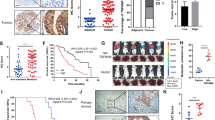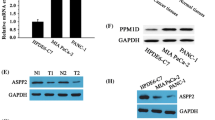Abstract
Background
HOXA10 is closely related to tumor progression in many human cancers. However, the role of HOXA10 in pancreatic cancer remains unclear. The aim of this study was to determine the involvement of HOXA10 in pancreatic cancer cell invasion and migration.
Methods
The effect of HOXA10 on the invasion and migration of pancreatic cancer cells was assessed by invasion and migration assays. The protein of transforming growth factor beta-2 (TGFβ2) was neutralized by TGFβ2 blocking antibody. The activation of p38 was inhibited by SB239063.
Results
HOXA10 could promote the invasion and migration of pancreatic cancer cells. Knockdown of HOXA10 decreased the expressions of TGFβ2 and matrix metallopeptidase-3 (MMP-3) and suppressed the activation of p38. Conversely, overexpression of HOXA10 increased the levels of TGFβ2 and MMP-3. Further experiments identified that TGFβ2 contributed to the HOXA10-promoted invasion and migration and regulated MMP-3 expression and p38 activation. Additionally, inhibition of p38 suppressed cell invasion and MMP-3 expression in pancreatic cancer cells.
Conclusions
HOXA10 promotes cell invasion and MMP-3 expression of pancreatic cancer cells via TGFβ2-p38 MAPK pathway. Thus, HOXA10 could be a useful target for the treatment of pancreatic cancer.








Similar content being viewed by others
References
Jemal A, Siegel R, Xu JQ, Ward E. Cancer statistics, 2010. CA Cancer J Clin. 2010;60:277–300.
Malaguarnera G, Giordano M, Paladina I, Berretta M, Cappellani A, Malaguarnera M. Serum markers of hepatocellular carcinoma. Dig Dis Sci. 2010;55:2744–2755.
Raman M, Chen W, Cobb MH. Differential regulation and properties of MAPKs. Oncogene. 2007;26:3100–3112.
Chen KN, Gu ZD, Ke Y, Li AY, Shi XT, Xu GW. Expression of 11 HOX genes is deregulated in esophageal squamous cell carcinoma. Clin Cancer Res. 2005;11:1044–1049.
Takahashi O, Hamada J, Abe M, et al. Dysregulated expression of HOX and ParaHOX genes in human esophageal squamous cell carcinoma. Oncol Rep. 2007;17:753–760.
Cheng WJ, Jiang Y, Liu CX, Shen OX, Tang WW, Wang XR. Identification of aberrant promoter hypomethylation of HOXA10 in ovarian cancer. J Cancer Res Clin Oncol. 2010;136:1221–1227.
Yamatoji M, Kasamatsu A, Yamano Y, et al. State of homeobox A10 expression as a putative prognostic marker for oral squamous cell carcinoma. Oncol Rep. 2010;23:61–67.
Tanwar PS, Kaneko-Tarui T, Lee HJ, Zhang L, Teixeira JM. PTEN loss and HOXA10 expression are associated with ovarian endometrioid adenocarcinoma differentiation and progression. Carcinogenesis. 2013;34:893–901.
Ko SY, Lengyel E, Naora H. The Mullerian HOXA10 gene promotes growth of ovarian surface epithelial cells by stimulating epithelial-stromal interactions. Mol Cell Endocrinol. 2010;317:112–119.
Chu MC, Selam FB, Taylor HS. HOXA10 regulates p53 expression and matrigel invasion in human breast cancer cells. Cancer Biol Ther. 2004;3:568–572.
Sentani K, Oue N, Naito Y, et al. Upregulation of HOXA10 in gastric cancer with the intestinal mucin phenotype: reduction during tumor progression and favorable prognosis. Carcinogenesis. 2012;33:1081–1088.
Yamamoto H, Itoh F, Iku S, et al. Expression of matrix metalloproteinases and tissue inhibitors of metalloproteinases in human pancreatic adenocarcinomas: clinicopathologic and prognostic significance of Matrilysin expression. J Clin Oncol. 2001;19:1118–1127.
Uhl M, Aulwurm S, Wischhusen J, et al. SD-208, a novel transforming growth factor beta receptor I kinase inhibitor, inhibits growth and invasiveness and enhances immunogenicity of murine and human glioma cells in vitro and in vivo. Cancer Res. 2004;64:7954–7961.
Shah CA, Bei L, Wang H, Platanias LC, Eklund EA. HoxA10 protein regulates transcription of gene encoding fibroblast growth factor 2 (FGF2) in myeloid cells. J Biol Chem. 2012;287:18230–18248.
Shah CA, Wang H, Bei L, Platanias LC, Eklund EA. HoxA10 regulates transcription of the gene encoding transforming growth factor beta2 (TGFbeta2) in myeloid cells. J Biol Chem. 2011;286:3161–3176.
Li B, Jin H, Yu Y, et al. HOXA10 is overexpressed in human ovarian clear cell adenocarcinoma and correlates with poor survival. Int J Gynecol Cancer. 2009;19:1347–1352.
Chen Y, Zhang J, Wang H, et al. miRNA-135a promotes breast cancer cell migration and invasion by targeting HOXA10. BMC Cancer. 2012;12:111.
Baba M, Itoh K, Tatsuta M. Glycine-extended gastrin induces matrix metalloproteinase-1-and-3-mediated invasion of human colon cancer cells through type I collagen gel and Matrigel. Int J Cancer. 2004;111:23–31.
Dehnavi E, Soheili ZS, Samiei S, Ataei Z, Aryan H. The effect of TGF-beta2 on MMP-2 production and activity in highly metastatic human bladder carcinoma cell line 5637. Cancer Invest. 2009;27:568–574.
Arslan F, Bosserhoff AK, Nickl-Jockschat T, Doerfelt A, Bogdahn U, Hau P. The role of versican isoforms V0/V1 in glioma migration mediated by transforming growth factor-beta2. Br J Cancer. 2007;96:1560–1568.
Wick W, Grimmel C, Wild-Bode C, Platten M, Arpin M, Weller M. Ezrin-dependent promotion of glioma cell clonogenicity, motility, and invasion mediated by BCL-2 and transforming growth factor-beta2. J Neurosci. 2001;21:3360–3368.
Do TV, Kubba LA, Du H, Sturgis CD, Woodruff TK. Transforming growth factor-beta1, transforming growth factor-beta2, and transforming growth factor-beta3 enhance ovarian cancer metastatic potential by inducing a Smad3-dependent epithelial-to-mesenchymal transition. Mol Cancer Res. 2008;6:695–705.
Salzman SA, Mazza JJ, Burmester JK. Regulation of colony-stimulating factor-induced human myelopoiesis by transforming growth factor-beta isoforms. Cytokines Cell Mol Ther. 2002;7:31–36.
Ono K, Han J. The p38 signal transduction pathway: activation and function. Cell Signal. 2000;12:1–13.
Sergeant G, van Eijsden R, Roskams T, Van Duppen V, Topal B. Pancreatic cancer circulating tumour cells express a cell motility gene signature that predicts survival after surgery. BMC Cancer. 2012;12:527.
Cho SB, Park YL, Park SJ, et al. KITENIN is associated with activation of AP-1 target genes via MAPK cascades signaling in human hepatocellular carcinoma progression. Oncol Res. 2011;19:115–123.
Dreissigacker U, Mueller MS, Unger M, et al. Oncogenic K-Ras down-regulates Rac1 and RhoA activity and enhances migration and invasion of pancreatic carcinoma cells through activation of p38. Cell Signal. 2006;18:1156–1168.
Huang XY, Wang HC, Yuan Z, Huang J, Zheng Q. Norepinephrine stimulates pancreatic cancer cell proliferation, migration and invasion via beta-adrenergic receptor-dependent activation of P38/MAPK pathway. Hepatogastroenterology. 2012;59:889–893.
Conflict of interest
None.
Author information
Authors and Affiliations
Corresponding author
Rights and permissions
About this article
Cite this article
Cui, XP., Qin, CK., Zhang, ZH. et al. HOXA10 Promotes Cell Invasion and MMP-3 Expression Via TGFβ2-Mediated Activation of the p38 MAPK Pathway in Pancreatic Cancer Cells. Dig Dis Sci 59, 1442–1451 (2014). https://doi.org/10.1007/s10620-014-3033-6
Received:
Accepted:
Published:
Issue Date:
DOI: https://doi.org/10.1007/s10620-014-3033-6




